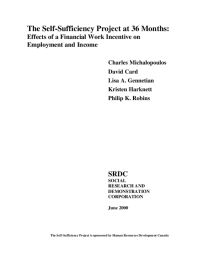The Self-Sufficiency Project at 36 Months: Effects of a Financial Work Incentive on Employment and Income
For decades, policymakers have struggled to find policies that encourage welfare recipients to work but preserve an adequate safety net. During the 1990s, many Canadian provinces introduced policies to encourage work by reducing basic assistance levels, instituting programs that provided work experience, or imposing sanctions on able-bodied recipients who did not look for work. In 1996, the block fund Canada Health and Social Transfer program provided provinces with greater flexibility in designing their programs, and provinces responded by stepping up their efforts. While a number of strategies have been found to encourage welfare recipients to work, people who move from welfare to work often end up no better off financially, because their increased earnings are offset by reduced amounts of public assistance.
The Self-Sufficiency Project (SSP) meets this challenge head-on. Conceived and funded by Human Resources Development Canada (HRDC), SSP is a research and demonstration project to test a policy innovation that makes work pay better than welfare. Managed by the Social Research and Demonstration Corporation (SRDC), and evaluated by the MDRC and SRDC, SSP was run in New Brunswick and the lower mainland of British Columbia from November 1992 to December 1999. SSP offered a temporary earnings supplement to selected single-parent, long-term Income Assistance (IA) recipients, about 95 percent of them women. The earnings supplement was a monthly cash payment available to single parents who had been on Income Assistance for at least one year and who left Income Assistance for full-time work within a year of entering the SSP program. The supplement was paid on top of earnings from employment for up to three continuous years, as long as the person continued to work full time and remained off Income Assistance. While collecting the supplement, an eligible single parent received an immediate payoff from work; in most cases, her total income before taxes was about twice her earnings.
To measure the effects of its financial incentive, SSP was designed as a social experiment using a rigorous, random-assignment research design. An earlier report (Lin et al., 1998) described the implementation of the program and the impacts of the program through 18 months, and found that SSP had doubled full-time employment and substantially increased income.
The current report updates many of the findings of the prior report by describing the impacts of the supplement offer, using information for 4,961 single parents who completed a survey (the “36-month interview”) about three years after they entered the study. The report also examines whether the supplement offer resulted in wage growth and stable employment. A companion report (Morris and Michalopoulos, 2000) examines the effects of SSP on the children of the parents studied in this report.






